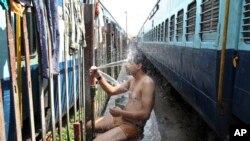A searing heat wave sweeping large parts of India has killed more than 1100 people, mostly in the southeastern states of Andhra Pradesh and Telangana.
As temperatures crossed or hovered around 46 degrees Celsius across the vast plains of India, those who had a choice remained indoors to escape the killer heat.
But tens of thousands such as construction laborers, taxi and auto rickshaw drivers and street vendors could not afford to escape the scorching sun.
Among them is Shaibaz Qureshi who plies an autorickshaw in Hyderabad, the capital of Andhra Pradesh and Telangana states.
He said the weather is a problem, but if he looks at the heat and stops working, then he will not be able to earn his daily income.
Under the glare of the unrelenting heat, the death toll has climbed steadily in the past week. The bulk of the deaths have occurred in the neighboring southeastern states of Andhra Pradesh and Telangana, which have recorded the country’s highest temperatures.
Record breaker
Y.K. Reddy, the head of the Meteorological Department in Hyderabad, told VOA it is the worst heat wave to hit the region in nearly a decade. “This summer season, three records are broken, three places, the temperatures have overshot the previous records. In other places records are not broken, but we have reached 47 degrees [Celsius] plus in coastal Andhra Pradesh,” he said.
Although high temperatures are common in India in May and June, dry, scorching winds blowing from the north west have intensified the heat in the past week not just in Telangana and Andhra Pradesh, but all across northern and central India.
That includes the capital New Delhi, where a national daily, Hindustan Times, showed a photograph of street tar and paint, on the stripes of a pedestrian crossing, melting.
Sunil Kumar Aledia of the Center for Holistic Development in New Delhi said the most vulnerable to the extreme heat are homeless people. He said these people usually spend the night in government shelters in winter, but they get no respite from the torrid weather in summer.
Aledia said these shelters are usually cabins or tin structures and their occupancy is barely 10 per cent in summer. He said this is because they lack facilities such as fans, coolers or drinking water facilities, and become very hot.
What to do
Authorities across the worst affected states advise people to stay indoors during the afternoon, not to venture out without caps and to drink plenty of fluids. In some places such as Andhra Pradesh, they cancelled the leave of doctors as hospitals were flooded with cases of heat stroke.
In Kolkata, the death of two taxi drivers due to heat stroke last week prompted taxi unions to tell cab drivers that they could turn down passengers in the afternoon. Many cabs in Indian cities are not air conditioned. In the eastern state of Orissa, the government advised laborers to suspend hard work between 11 am and 4 pm.
The arrival of annual monsoon rains at the end of the month or early June could bring some relief from the sweltering heat. But the worst affected states may not get an early respite because the rains hit the south and west of India before arriving in the northern and eastern plains, which are bearing the brunt of the heat wave.
However in Hyderabad, Meteorological Department head Reddy hopes that stray thunder showers will moderate temperatures in the coming days.







